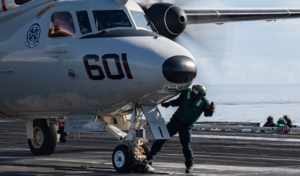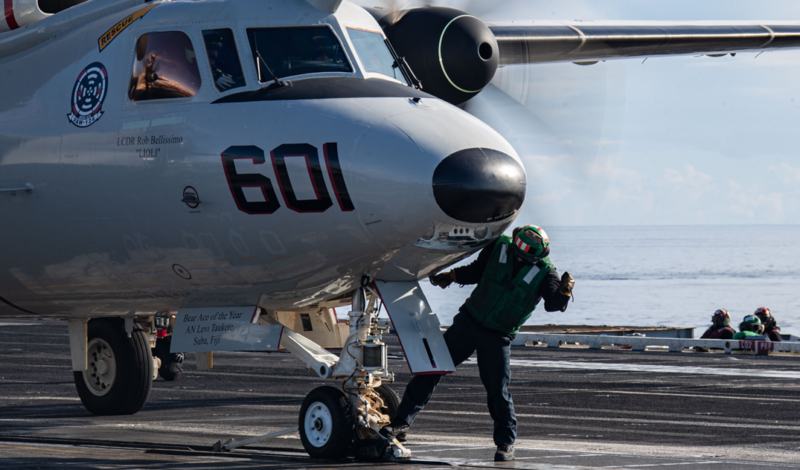
MEDITERRANEAN SEA (Dec. 11, 2023) Aviation Boatswain’s Mate (Equipment) 2nd Class Hunter Athey, assigned to the air department of the world’s largest aircraft carrier USS Gerald R. Ford (CVN 78), sets tension on an E-2D Hawkeye, attached to the “Bear Aces” of Airborne Command and Control Squadron (VAW) 124, on the flight deck. SPB will be rolled out to all type/model/series aircraft. (U.S. Navy photo by Mass Communication Specialist 3rd Class Maxwell Orlosky)
Program office decision makers, engineers, logisticians and other stakeholders now have an improved and comprehensive information technology solution that supports quicker and deeper analyses of weapon systems’ long-term sustainment health and interdependent processes. Called the Sustainment Program Baseline (SPB) Dashboard, it tracks a weapon system’s sustainment phase performance against an established baseline.
First developed in 2021 and updated in the fall of 2023 to improve show causation-effect relationships and background functionality, the SPB Monitoring Dashboard pulls data from multiple sources from across naval aviation and aggregates it to give a comprehensive picture of a weapon system’s sustainment health, according to Sustainment Performance & Optimization Team Director Michael Kaczmarek.
“It currently displays 74 metrics in an automated hierarchical format, showing the relationships of material and sustainment metrics to operational requirements,” he explained. “Eight programs can now look at this real-time data with just a glance.” The team is working to incorporate more than 120 additional holistic metrics.
The dashboard supports SPB, a planning, management and governance approach with quantitative measures of success used by program managers, resource sponsors and acquisition executives to govern and manage the sustainment strategy for the life of the program. It was developed to answer the call from the 2018 Fiscal Year National Defense Authorization Act and senior Navy leadership for a process to monitor the health of weapon systems throughout their acquisition and sustainment phases, to include maintenance. The NAVAIR Sustainment Group partnered with the Deputy Assistant Secretary of the Navy (DASN) for Sustainment and Commander, Naval Air Forces (CNAF) to develop the solution.
The SPB Dashboard also significantly reduces the time program office’ spend collecting and processing data, Sustainment Performance & Optimization Team Deputy Director Laurie Zuniga said.
“Before this version, program managers gathered data and conducted analysis either by hand or via multiple online sources,” she said. “When defining its requirements, program decision makers wanted to make it easier to determine if a program was meeting its objective thresholds. They also needed the ability to drill down and identify root causes so that mitigation strategies could be implemented.”.
“Now that the process is fully automated and we can see how scheduled maintenance and unscheduled maintenance impacts a weapon system’s fully mission capable rates and availability status,” Independent Logistics Assessment Lead and team member Jimmy Brown said. “That information is available down to the level of each aircraft. It also aligns to a weapon system’s Life Cycle Sustainment Plan (LCSP).” (An LCSP is framework that enables users to think systematically and critically through the set of planning factors that must be integrated and communicated across the enterprise to achieve required sustainment outcomes.)
“This is the first time this level of synthesis of information is available,” he added.
Brown said the team’s work is not finished.
“Use of the SPB Dashboard will be expanded to include all naval aviation aircraft,” he said. “After additional updates to this version are completed, the dashboard will depict driver-tree views that show causation-effect relationships for all naval aircraft.”
“SPB 3.0 will pull in data from commercial sources, unmanned aircraft systems and other commodities,” he explained, “providing users with greater visibility into the interdependencies of processes and enhance users’ data-informed decision-making.”
“This capability transforms how we approach prioritization of resources in naval aviation,” Kaczmarek said. “It’s an important milestone in the maturation of the SPB.”

MEDITERRANEAN SEA (Dec. 11, 2023) Aviation Boatswain’s Mate (Equipment) 2nd Class Hunter Athey, assigned to the air department of the world’s largest aircraft carrier USS Gerald R. Ford (CVN 78), sets tension on an E-2D Hawkeye, attached to the “Bear Aces” of Airborne Command and Control Squadron (VAW) 124, on the flight deck. SPB will be rolled out to all type/model/series aircraft. (U.S. Navy photo by Mass Communication Specialist 3rd Class Maxwell Orlosky)


